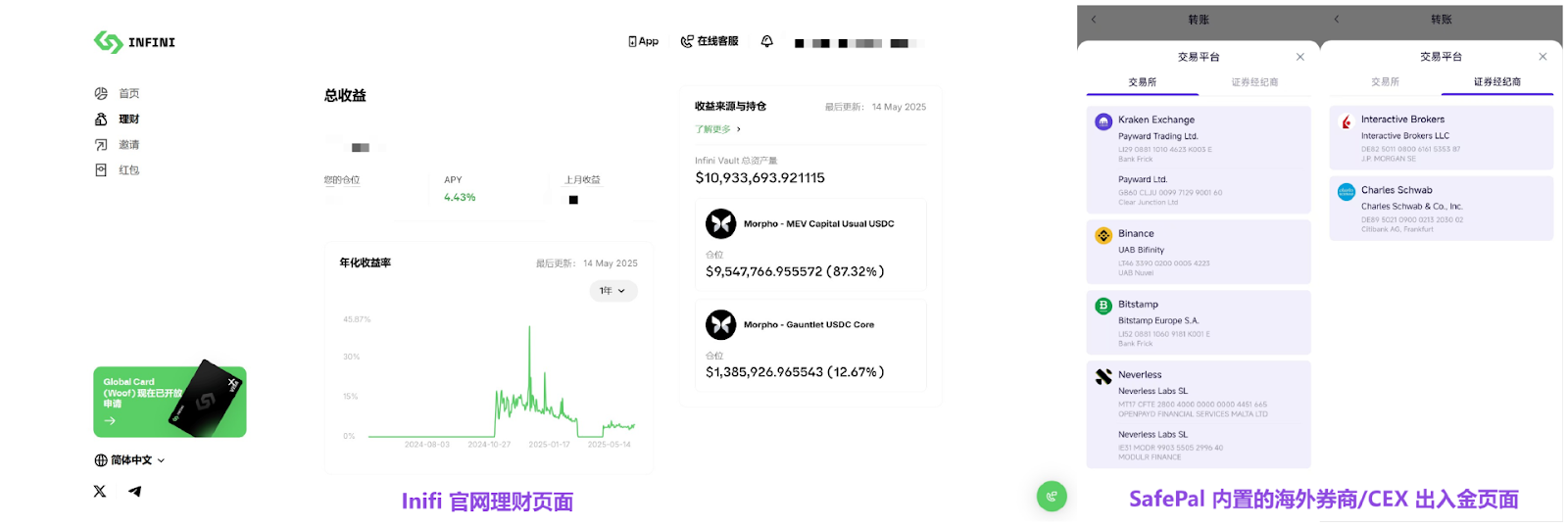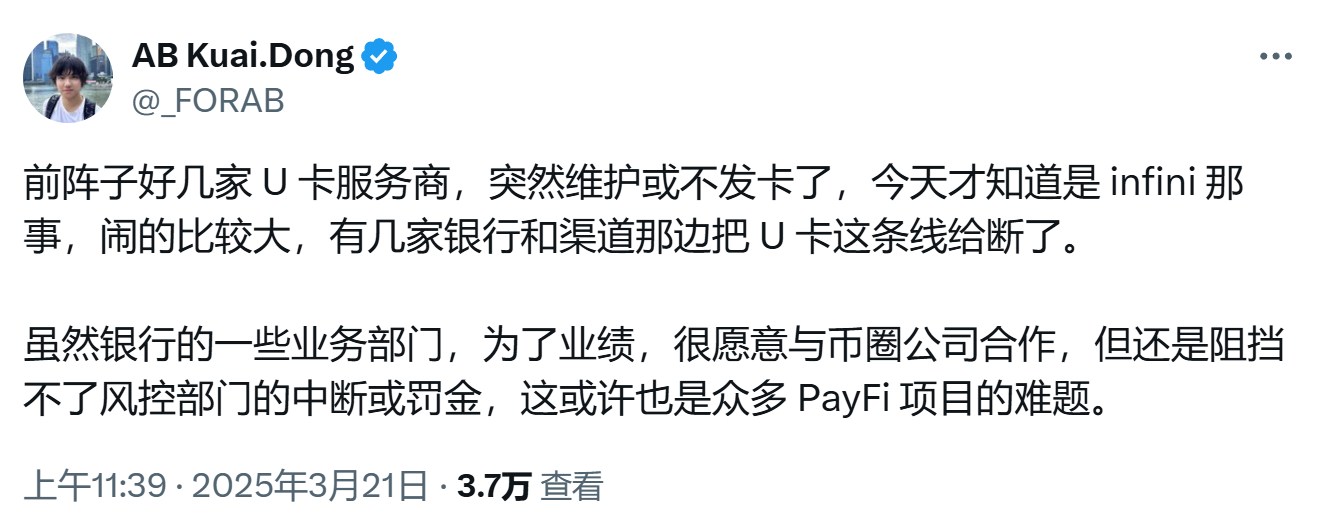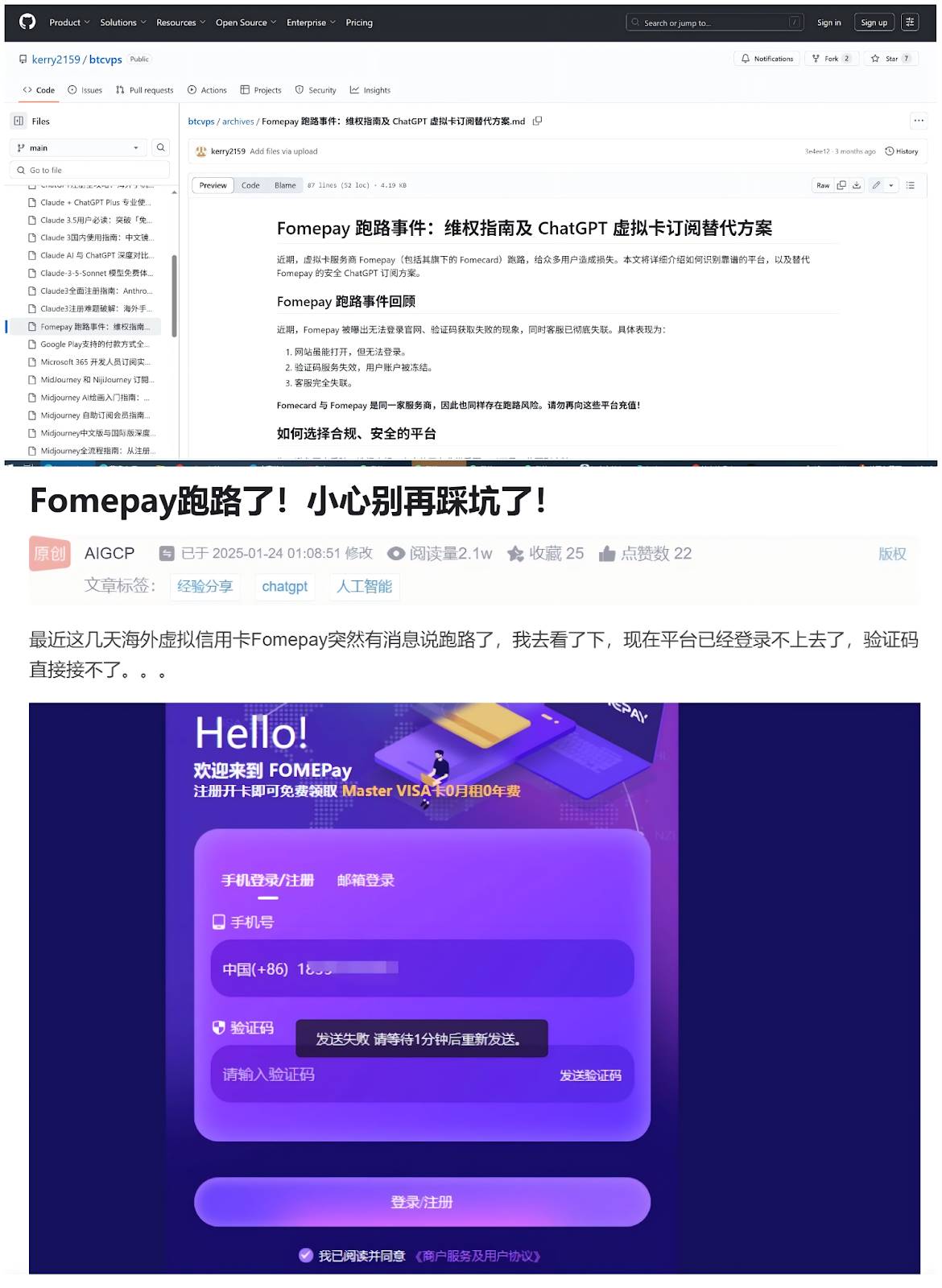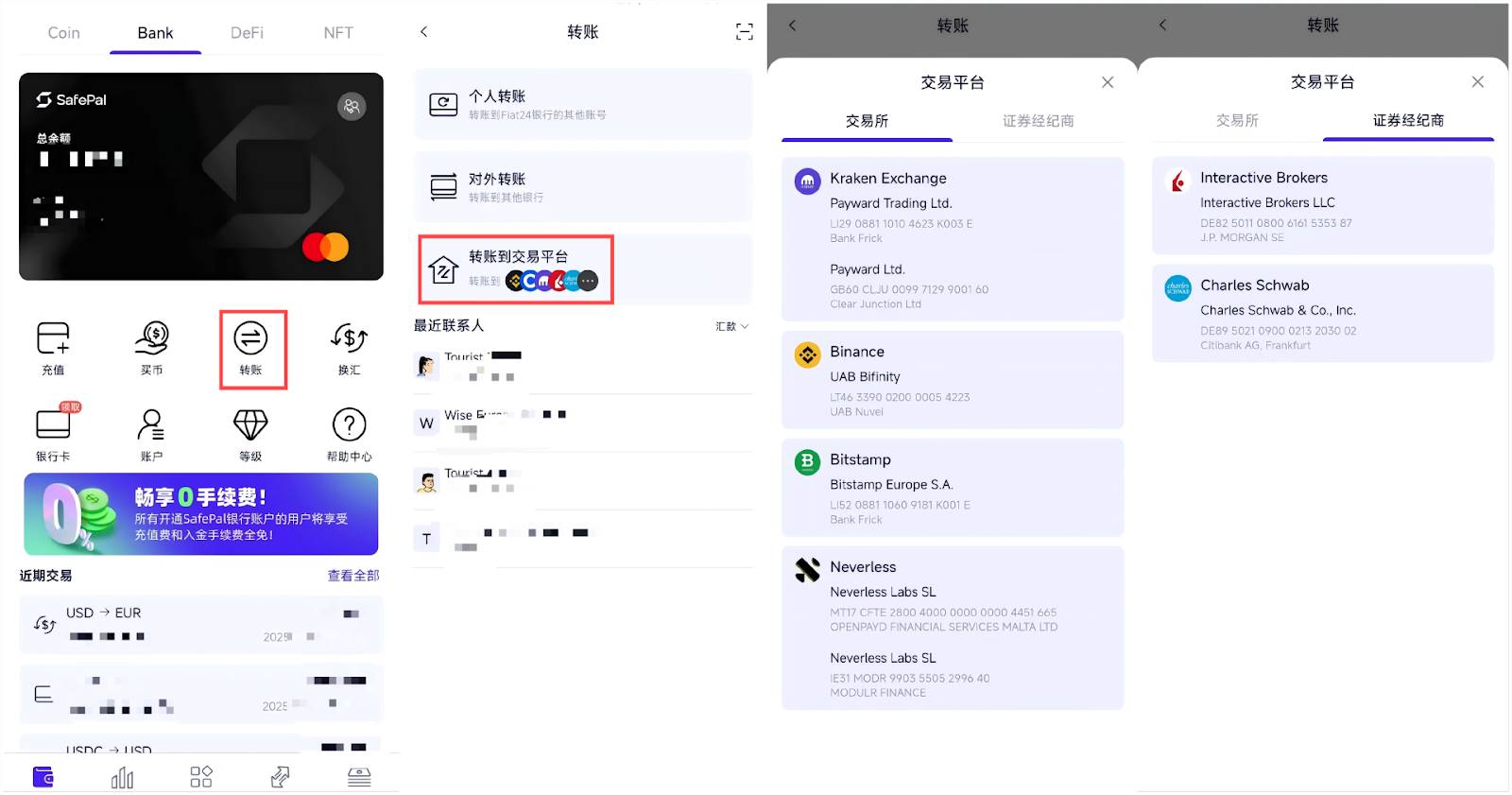The exit of "Pure U Cards" is just a matter of time. Will the broader "Card+" services be an exception in this cycle of change?
Written by: Web3 Farmer Frank
How many "U Cards" do you have in your hand right now?
From the early Dupay and OneKey Card to the Card launched by exchanges Bitget and Bybit, and then to the crypto payment card services from Infini, Morph, and SafePal, even Coinbase and MetaMask have joined the fray. This year, crypto payment cards (U Cards) targeting the PayFi narrative have almost become standard for Web3 projects.
In the new round of players racing to establish their presence, promotional tweets and review information about various U Cards are overwhelming, reminiscent of the colorful shared bicycles that once filled the streets. The plethora of options has shifted the market's focus from usability to comparisons based on registration/use thresholds, fees, and other dimensions, trying to find the best value for money in the "sea of cards."
However, if we observe over a longer time frame, we find that the apparent prosperity of the U Card sector cannot hide its underlying fragility. Simply put, the lifecycle of a U Card is sometimes not even longer than that of some meme coins: there are countless cases of exit scams, shutdowns, and card replacements, and most of the crypto payment card players from the last wave have long since disappeared.
The reason is simple: security and compliance have always been the sword of Damocles hanging over all U Cards. In addition to heavily relying on the compliance willingness of channel banks for crypto business, U Cards themselves also have inherent structural flaws—the custody of the fund pool is in the hands of the service provider, which poses a significant test for operational capability and moral standards. If either the cooperating bank or service provider encounters issues, users may become innocent collateral damage…

For the current "hundred groups battle," the underlying fee costs of U Cards are mostly similar, and user experience often relies on subsidies and high-interest measures. However, these short-term incentives clearly cannot build true long-term competitiveness. Once subsidies decline, faced with homogeneous card consumption services, it is hard to say which brand users will remain loyal to in the long run.
Therefore, as the traditional U Card model gradually reveals its ceiling, some crypto payment card services are beginning to emerge with new variables, exploring interesting attempts from multiple dimensions such as wealth management and bank accounts:
For example, the star project Infini's "Card + Wealth Management" model provides custodial interest income for users' Crypto assets through on-chain DeFi configurations; the established wallet SafePal's "Card + Bank Account" model allows users to truly hold a personal real-name Swiss bank account, achieving an overseas broker/CEX deposit and withdrawal experience under the Euro/Swiss Franc framework.
Objectively speaking, whether broader "Card+" services can truly break out of the cycle and become an exception remains to be further tested by the market. However, it is certain that only those crypto payment card projects that can achieve a balance in security, compliance, and user experience may have the potential to break the "short-lived" curse in this "chaotic era."
Crypto Payment Cards: Hard to Call "Evergreen"
Why have U Cards transformed from a niche track into a coveted "hotcake" that everyone is scrambling for?
There are two core reasons behind this.
First, in the backdrop of a market that seems bearish yet bullish (it was "bear market" when written, "bull market" when published, and what will it be when you read this?), crypto payment cards have become a good business that not only generates buzz but also attracts traffic: they not only have a clear profit model and stable cash flow but also significantly enhance user activity and community stickiness.
After all, one of the biggest pain points for Web3 players, especially those in mainland China, is the deposit and withdrawal: how to directly use Crypto for daily consumption payments, and how to convert Fiat into Crypto in a compliant and convenient manner has always been a naturally strong demand landing scenario.
Thus, for Web3 projects that urgently need to expand their business boundaries, regardless of whether they were originally strongly related to the PayFi track, they are almost all eager to enter this field, making U Cards a rare "certain business" and the best business expansion outlet in the eyes of many Web3 projects.
Secondly, in addition to market demand, the low entry barrier for issuing crypto payment cards is also an important factor attracting many project parties. They are usually issued in collaboration between Web3 project parties (such as Infini and Bybit mentioned earlier) and traditional financial institutions (banks and other issuing institutions), presenting a three-tier structure of "Card Organization - Issuing Institution - Web3 Project."

Taking the commonly seen Mastercard U Card as an example:
Card Organization: This is Mastercard, whose allocated card BIN number segment (the first six digits of the bank card) is the core resource of the payment system, directly authorized by the card organization to the primary issuing institutions (such as licensed banks, electronic money institutions);
Primary Issuing Institution: Licensed financial institutions like Singapore's DCS Bank (DeCard) are responsible for compliance-related fund custody and card BIN management;
Web3 Project Party: As secondary issuers, they cannot directly obtain card BINs and can only obtain technical authorization through cooperation with primary institutions, responsible for product design and operation on the user end;
The primary issuing institution plays a key role in the entire chain, responsible for interfacing with the card organization, mastering consumption data, and handling risk control matters such as freezing and blocking cards, while Web3 project parties focus on brand building and user operation, constructing a business model for traffic conversion.
However, the risk point lies here: if a secondary issuer is reported for violations (such as money laundering, unclear fund flows, etc.), the card organization or regulatory agency may impose direct penalties. Even if there are no direct violations, some banks may tighten cooperation due to regulatory pressure or risk control considerations.
This leads to the relevant U Card services facing shutdown risks at any time, explaining why so few of the many emerging "U Card" projects can survive for a year or so.

Of course, there is a deeper issue: the risk of fund security. In this structure, the vast majority of U Cards are essentially prepaid cards that require users to recharge funds first, obtaining only a "spending limit" based on the recharge record, rather than independent custody of real assets.
This is no different from the gym cards or supermarket recharge cards we are familiar with. For example, suppose you spend 5000 yuan at a gym to obtain a stored-value card; the funds go directly into the gym's bank account. The gym promises that each time you consume, the amount will be deducted from the card limit, but there is no independent 5000 yuan cash stored in the card; instead, it forms a "fund pool" with the recharge funds of other members.
The gym might use this fund pool to pay rent, purchase equipment, or even invest in other branches. However, if one day the gym goes bankrupt due to poor management or the owner runs away with the money, your stored-value card limit will become "waste paper" because you never truly owned "your 5000 yuan"; you only had a "debt claim" against the gym.

The same applies to U Cards. When you recharge 100 USDT/USDC, it directly enters a unified fund pool controlled by the secondary issuer, and the "Fiat limit" you receive from the U Card is merely a sub-account under the company account opened by the issuing institution based on the recharge situation, used only for payment settlement. There are no actual Fiat deposits in the card—you can use it for consumption but cannot transfer freely.
In other words, the Crypto assets that users recharge mostly flow directly into the project party's on-chain account, rather than a true banking account system. The corresponding Fiat side has not opened an independently named account for users; it merely allocates spending limits through a unified account, and your "limit" is essentially just a string of numbers. Whether it can be redeemed entirely depends on the platform's survival capability and willingness to redeem.

This model means that the security and stability of the entire system almost entirely rely on the moral standards and risk control capabilities of the project party.
When the accumulated user funds reach a certain scale, if the project party encounters moral hazards (such as misappropriating funds or running away with money) or risk control failures (such as a broken capital chain, hacking, or inability to cope with large-scale withdrawals), user assets will face the risk of loss or even irretrievability (cases of U Card exit scams abound online).
Currently, whether it is U Card products launched by exchanges or crypto payment cards from well-known projects, the vast majority belong to prepaid cards, making it difficult to establish a long-term business. Of course, U Cards issued by platforms with good reputations and compliance capabilities can reduce risks to some extent.
"Card+" Services: A New Variable for Crypto Payment Cards?
For this reason, more and more project parties are no longer satisfied with a single U Card service but are actively seeking to transform towards more financial attributes and long-term value.
For instance, Bitget and SafePal have begun to invest in crypto-friendly banks with financial licenses (such as DCS and Fiat24), no longer focusing solely on the "U Card" business but instead working to establish a comprehensive financial service system of "Card + Bank Account," stepping out of the single consumption tool business scope.
Taking SafePal as an example, at the beginning of 2024, it disclosed a strategic investment in the Swiss compliant bank Fiat24 and officially launched personal Swiss bank accounts and co-branded Mastercard services aimed at users including those from mainland China at the end of last year. I also tested and experienced this "above U Card" service model.

In simple terms, the biggest advantage of this "non-U Card" model is that it fundamentally solves the fund security issues present in traditional U Cards—users directly hold a bank account in their name, and funds enter a real banking system rather than being stored in the project party's fund pool, effectively reducing the risks of exit scams, runs, and redemption issues.
Even in extreme cases where the Web3 project itself encounters problems, users can still independently withdraw funds through the banking system. This independence and security of funds is something that the traditional U Card model cannot compare to.
More importantly, this model opens up a broader channel for deposits and withdrawals, achieving a seamless connection between the TradFi and Crypto worlds in a certain sense: taking the banking account services of SafePal & Fiat24 as an example, users can not only complete free deposits and withdrawals with overseas brokers (such as Interactive Brokers and Charles Schwab) and CEX through their personal bank accounts but can also transfer funds back to Alipay/WeChat or domestic banks through channels like Wise (Euro SEPA transfers), creating a closed loop of asset flow between on-chain and off-chain (for further reading, see “SafePal Practical Manual: Transfer Remittance, Deposit and Withdraw Brokers/CEX, The Most Comprehensive Guide to Connecting Crypto and TradFi”).
In contrast, most U Card products remain stuck in the stage of subsidy and fee competition. Taking Bybit as an example, it attracts users through a high cashback strategy, but a cashback of 10% or even higher indicates that fee competition is nearing its limit. Once subsidies decline, the severely homogenized product experience cannot retain users, let alone build true brand loyalty.
This structural contradiction makes it difficult for most pure U Card products to survive the cycle, while the broader "Card + Bank Account" model may be the direction for a few projects to break through.
I have also summarized the current market's reputable crypto payment card products, providing a rough comparison of registration thresholds, fee structures, and compliance functionalities during actual use:

From this comparison, it is clear that the "Card + Bank Account" model adopted by SafePal currently has significant advantages in terms of fund security, fees, and functionality, especially in compliance and support for actual deposit and withdrawal scenarios, creating a competitive barrier that is difficult to replicate.
On the surface, crypto payment cards compete on fee subsidies, but in reality, they are competing for who can grasp the truly scarce compliance resources and financial infrastructure. Only players who hold licenses and bank-level resources are likely to emerge victorious in this chaotic era.
From "U Card" to the New Narrative Curve of "Card + Bank Account"
Starting in 2025, Web3 payments have somewhat reached a narrative turning point.
The biggest difference lies in the fact that the entire track, which previously focused mostly on 2B enterprise service crypto payment solutions, is now seeing more leading institutions entering the 2C consumer scene. A representative case is OKX's newly launched OKX Pay, which directly targets the personal payment market, leveraging its own traffic and ecological advantages to tap into the mass market.
From a development trend perspective, the exit of the "pure U Card" model is just a matter of time, as the market has gradually evolved from a single payment tool to a comprehensive asset management tool. After all, U Cards only achieve "consumer terminal reach" but cannot construct a complete ecological closed loop for fund circulation—when users need to remit funds to Interactive Brokers, 99% of U Cards can only remain silent.
Therefore, transcending the simple positioning of a consumption card and integrating functions such as savings, investment, and remittance is essential to capture the new narrative curve.
Just like the approach of SafePal & Fiat24, which allows users to directly deposit into Interactive Brokers for stock trading through Euro accounts, and also freely remit to Alipay using tools like Wise, achieving free flow of funds on-chain and off-chain, enabling Crypto wallets to possess capabilities akin to a fully functional commercial bank account.

From this perspective, Web3 wallets inherently possess the capability for crypto asset management and are the most ideal carriers for PayFi services. This is also the fundamental reason why OKX Pay and SafePal are accelerating the promotion of the "Card + Bank Account" model. They aim to provide a new asset management experience that integrates the convenience of virtual cards, the security of compliant bank accounts, and the characteristics of decentralization:
Users can enjoy decentralized features through non-custodial wallets while also leveraging Visa and Mastercard networks for global consumption payments, all while enjoying financial services close to traditional banks (transfers, remittances, deposits, and withdrawals), yet still retaining the flexibility of crypto assets.
In the future, as crypto assets further integrate into the global financial system, this model may be the ultimate solution for achieving large-scale user growth.
The evolution from "U Card" to "Card + Bank Account" has clearly demonstrated the path for crypto payment cards to break through—finding a new narrative curve, shifting from a single consumption tool to a comprehensive asset management entry point.
Future competition will no longer be about who offers more cashback, but rather who can truly bridge the last mile between Crypto and TradFi. This market ultimately belongs to those long-termists who can build financial infrastructure and possess compliance resources, rather than short-term arbitrage flow players.
In Conclusion
Returning to the initial question: Can crypto payment cards become a sustainable business?
The so-called "short-lived" essentially reflects the inherent flaws in the business model—over-reliance on subsidy-driven growth, lack of a compliance moat, and genuine user stickiness. When subsidies decline and regulations tighten, this seemingly lively game will naturally come to an end.
However, this does not mean the story will end here.
In other words, "short-lived" is not necessarily fate, but to achieve "evergreen" status, a new business model that aligns with the essence of finance and can transcend cycles must be articulated.
免责声明:本文章仅代表作者个人观点,不代表本平台的立场和观点。本文章仅供信息分享,不构成对任何人的任何投资建议。用户与作者之间的任何争议,与本平台无关。如网页中刊载的文章或图片涉及侵权,请提供相关的权利证明和身份证明发送邮件到support@aicoin.com,本平台相关工作人员将会进行核查。




